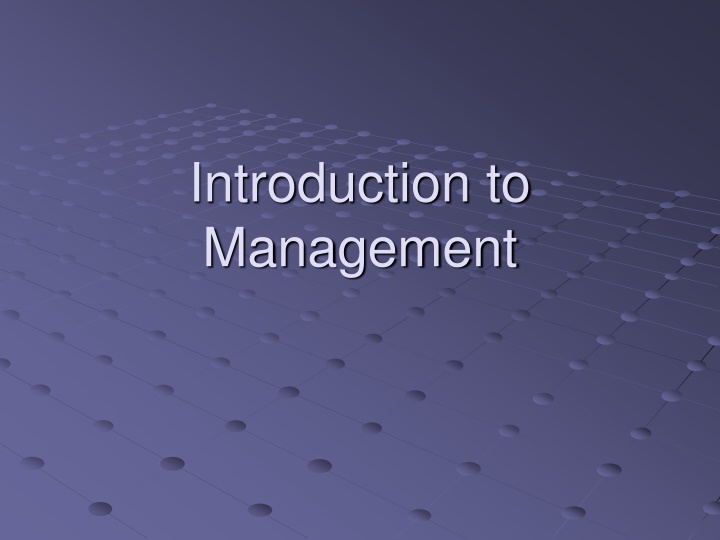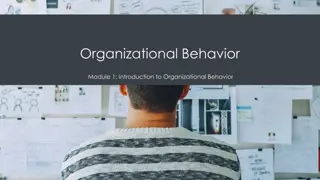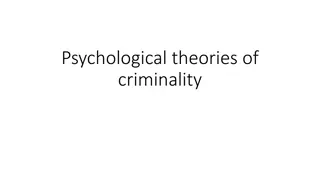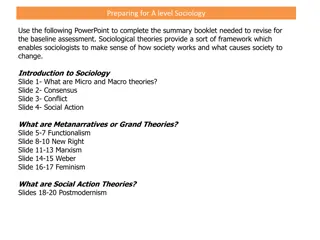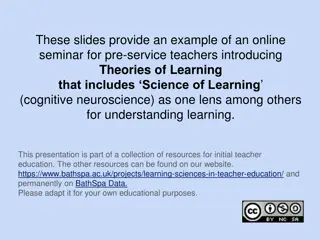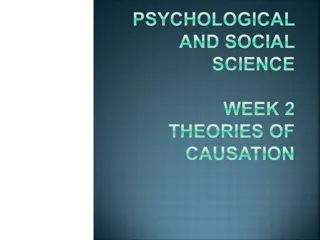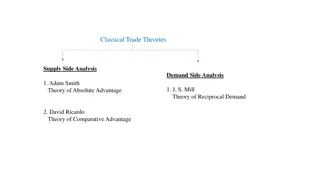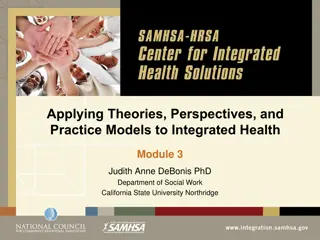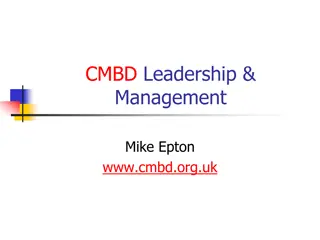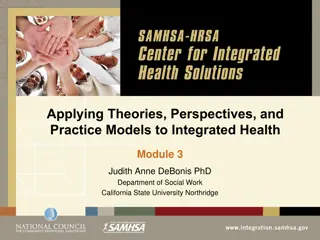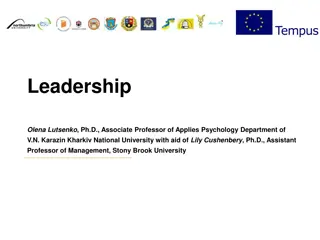Introduction to Management Topics and Theories
This content covers various aspects of management, including what managers do, challenges they face, major management theories, and the management process. It delves into organizational behavior, systems analysis, and the roles of professionals like CEOs.
Download Presentation

Please find below an Image/Link to download the presentation.
The content on the website is provided AS IS for your information and personal use only. It may not be sold, licensed, or shared on other websites without obtaining consent from the author.If you encounter any issues during the download, it is possible that the publisher has removed the file from their server.
You are allowed to download the files provided on this website for personal or commercial use, subject to the condition that they are used lawfully. All files are the property of their respective owners.
The content on the website is provided AS IS for your information and personal use only. It may not be sold, licensed, or shared on other websites without obtaining consent from the author.
E N D
Presentation Transcript
Introduction to Management
Topics What is management? What do managers do? What challenges do managers at different levels face?
Management The implementation of the four conditions that must be present for management to succeed: mission, authority, resources, and accountability
Mission The purpose or reason for the existence of an organization. Professional Manager A person employed to manage someone else s business.
Chief Executive Officer (CEO) The top administrator or manager of an organization; usually reports directly to the board of directors.
Major Management Theories Scientific Management The application of a systematic or scientific approach to the study of organizations. Bureaucracy Management The process of examining the organizational aspects of companies and their work flow to explain how institutions function and how to improve their performance.
Organizational Behavior Management A management approach that looks at the performance and interaction of people within organizations. Systems Analysis Management The analytical view of an organization as a complete, self-contained unit that interacts within itself and with its environment in a continuous process of interchange and renewal.
The Management Process: Planning The thought and analysis process that results in a formal strategy for realizing the goals of the organization. Organizing The process of assembling the necessary resources and people for implementing a plan of action.
The Management Process: Directing Leading in achieving the day- to-day tasks necessary to implement the management plan and ensure a smooth- running facility. Controlling The process of monitoring the standards, measurements, and feedback mechanisms that were set in place to ensure implementation of the management plan.
Management is Efficiency Getting work done through others Effectiveness 1
Management Functions Classical Updated Management Functions Management Functions Planning Making Things Happen Controlling Meeting the Competition Organizing Organizing People, Projects, and Processes Leading Leading 2
Levels of Management CEO COO Top Level Management Middle Level Management General Mgr Plant Mgr Regional Mgr First-Line Management Office Manager Shift Supervisor Department Manager Team Leader 3
Goal A broad, long-term ambition of the organization. Objective A measurable standard or task, set in a designated time frame.
Management by Objectives (MBO) A program for managing an organization by setting and monitoring performance objectives.
Generally, five conditions must be present for management to succeed: A mission, or goal, that organization or subunit expects to accomplish Leaders with the authority to direct the team toward the goal. Necessary resources (people, equipment, supplies, and money)
Responsibility for achieving the goals assigned Accountability for using the resources established
With these five ingredients present, management can be defined as the process of coordinating and implementing these five functions.
Roles of a Manager: People, Servant, Representative
The Manager as a Person: Talent and Knowledge Some people may appear to be natural leaders with inborn people skills. However, without an understanding of the management process, they soon fail when put in situations demanding extensive planning or technical knowledge
There may also be born organizers who thrive in situations that require exacting attention to detail. They too may quickly run into trouble when required to interact with or direct a group of people
The Manager as a Servant Seeing that the person who actually performs the tasks and work of the institution has the resources necessary to effectively and efficiently accomplish his or her duties is the responsibility of everyone from the CEO to the immediate supervisor.
The Manager as a Representative: The manager is a paid representative of the owners or board of directors in both for-profit and not-for-profit organizations. Managers must also represent those they supervise, as they are responsible for supplying their needs and presenting their concerns to the owners.
Some experts have argued that this representation function is the most important role of a manager in the successful operation of any business.
Management skills can be divided into four groups, each of which is a focus of a separate part of this course:
Organizational skills include the ability to conceptualize and apply the management process, systematize work flow, make decisions, and communicate with coworkers. People skills an understanding of the basic theories of human needs and work motivation is essential to accomplishing the goals of the individual and the organization.
Financial Management skills these skills involve the effective use of and accounting for the monetary assets of the company Technical skills involve the synthesis of the first three skills and the management of physical resources (supplies, equipment, facilities) into the operational parameters (product/services) unique to each organization.
Scientific Management represents the first orderly efforts to examine the functioning of complex organizations. The idea was to apply the scientific method of cause-and-effect analysis, used in the study of natural phenomena, to the examination of business enterprises.
Henri Fayol (1841-1925) first introduced the concept that management should be an orderly process of tasks and duties, of which planning was the most important.
Fayols thesis provides the base for the theory called the functions of management, or management process
Frederick Taylor (1856-1915) often called the father of scientific management, broke down each task into segments that could be analyzed for ways to improve efficiency
Other important scientific management innovators include Mary Parker Follet (1868-1933), who pointed out that management is essentially coordination, and LyndallUrwick (1891-1983), who introduced the role of the management consultant and attempted to classify and codify the work done on management theories.
Bureaucracy: The Study of Organizational Structure
Bureaucracy Management examines the organizational aspects and work flow of companies to explain how institutions function and how to improve the process. particular attention is given to the bureaucratic characteristics of organizations as they relate to rules, regulations, impersonality, and the division of labor
Bureaucracy is often spoken of negatively, for example, bureaucrat or red tape
In spite of this view, however, most academic and business consultants recommend focusing on the structure of the institutions and propose that implementing modifications in this area will improve management performance
For example, too many management layers may hinder communications and cause huge amounts of red tape, but too few layers may result in loss of control, thereby hindering management effectiveness
Organizational Behavior Management - This approach uses concepts from psychology and sociology as well as management theories. - The origins of these efforts lie in the studies conducted by Elton Mayo (1880-1949) between 1924 and 1932 at the Hawthorne Western Electric plant in Chicago.
Organizational Behavior Management Mayo s lead was followed by Douglas McGregor (1906-1964), who developed assumptions about the basic nature of man RensisLikert (1903-1981), whose writings encouraged managers to be supportive in their relationships; and Barnard, who recommended that executives encourage a climate of cooperation.
Systems Analysis Management - Analyzing businesses as a system was a natural evolution of scientific management. - The systems approach has been claimed by researchers who rely heavily on mathematical models, scientific methodology, and computer simulations to investigate management problems and recommend solutions.
Systems Analysis Management - These specialties include operations research, management science, and systems (computer) analysis.
Peter Druckers five basic management operations are setting objectives; organizing; motivating and communicating; establishing standards or measurements of performance; and developing people, including the managers themselves.
Most management texts, however, distill the management process into four main functions: planning, organizing, directing and controlling.
Planning Identify Goals, Evaluate Current Situation, Establish Time Frame, Set Objectives, Forecast Resource Needs, Implement Plan, Obtain Feedback Organizing Formal Hierarchy, Informal Relationships
Directing Leadership, Time Allocation Controlling Instructions, Follow-up, Modifications
Planning During the planning phase, managers attempt to anticipate the future and either shape it to their own ends or prepare for the coming changes.
Planning - It is the thinking and analyzing portion of the management process; the other three phases (organizing, directing, and controlling) focus on implementation of the plan developed in this initial stage.
The management planning process can be divided into seven steps:
1. Determine the goals the organization wishes to accomplish. 2. Collect information and evaluate the current situation, compared with where the enterprise wishes to be.
3. Establish a time frame or period in which to achieve the goals. 4. Set objectives that will move the company toward the desired future.
